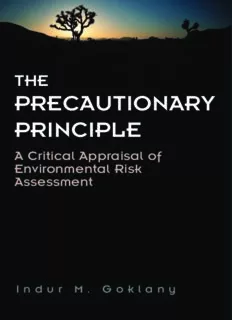
The Precautionary Principle: A Critical Appraisal PDF
Preview The Precautionary Principle: A Critical Appraisal
THE PRECAUTIONARY PRINCIPLE A Critical Appraisal of Environmental Risk Assessment I n d u r M . G o k l a n y Copyright © 2001 by the Cato Institute. All rights reserved. Library of Congress Cataloging-in-Publication Data Goklany, Indur M. The precautionary principle : a critical appraisal of environment risk assessment / Indur M. Goklany. p. cm. Includes bibliographical references and index. ISBN 1-930865-16-3 1. Environmental risk assessment. I. Title. GE145 .G64 2001 363.7'02–dc21 2001047310 Cover design by Elise Rivera. Printed in the United States of America. CATOINSTITUTE 1000 Massachusetts Ave., N.W. Washington, D.C. 2001 Contents 1. ESCAPINGGOBLINS, ONLYTOBECAPTUREDBYWOLVES? 1 2. DDT:SILENTSPRINGORSILENTPEOPLE? 13 3. THERISKSANDREWARDSOFGENETICALLYMODIFIEDCROPS 29 4. GLOBALWARMING:FROMTHEFRYINGPANINTOTHEFIRE? 57 5. ENSURINGTHATGOODINTENTIONSDONOTSPAWNBAD OUTCOMES 89 REFERENCES 95 INDEX 109 Acknowledgments I was fortunate to have support and encouragement from several quarters while writing this book. In particular, I thank Julian Morris for helping me embark on and persist in this endeavor. The book originated as a chapter in his fine book, Rethinking Risk and the Pre- cautionary Principle (Oxford: Butterworth Heinemann, 2000). I also thank Roger Bate, Ken Chilton, and Don Roberts for their detailed re- views and comments on earlier versions of various chapters in my book. I wrote parts of the book in the summer of 2000 while I was the D&D Foundation Julian Simon Fellow at the Political Economy Re- search Center in Bozeman, Montana. I am grateful to Terry Ander- son, Rich Stroup, Jane Shaw, Roger Meiners, P.J. Hill, Dan Benjamin, Roger Sedjo, Don Leal, and the entire PERC crew for their company and support during my tenure there. I was doubly fortunate in Boze- man to be the guest of Juliette Shaw and Eric Noyes, and the Mein- ers family. This book, moreover, would not have been published without the support of the Cato Institute’s Jerry Taylor, David Boaz, and David Lampo. Thanks to Ken Chilton, previous versions of the biotechnology and global warming chapters of this book appeared as policy studies from the Center for the Study of American Business (now the Wei- denbaum Center), Washington University in St. Louis. A version of the former also appeared in the Biotechnology Law Report. The DDT chapter was published on the “Save Children from Malaria Cam- paign” Web site, courtesy of Roger Bate and Kendra Okonski. And, of course, no such undertaking can ever be successful with- out constant support and encouragement from the home front. To Maya, Sam, and, especially, Karen, I dedicate this book. 1. Escaping Goblins, Only to Be Captured by Wolves? “What shall we do, what shall we do!” he cried. “Escaping goblins to be caught by wolves!” —J. R. R. Tolkien, The Hobbit, p. 98 So what do we do if we come to a fork in the road and one way leads through territory inhabited by goblins and the other through country infested by wolves? Which road should we take? Does it even matter if we take one road and not the other? Policymakers in the environmental and public health arena often face such dilemmas. DDT (dichlorodiphenyltrichloroethane) is a classic case. On one hand, this much-reviled chemical is a proven, cheap, and effective method of reducing malaria, a disease that an- nually afflicts 300 million people and claims over a million lives worldwide (WHO 2000). Over the years, DDT has saved millions of lives not only in Asia and Africa but also in Europe and the Ameri- cas. But DDT has also been implicated in the decline of a number of raptors such as the bald eagle and the peregrine falcon. It has been found in various avian eggshells, in the tissues of fish, and in moth- ers’ milk. Some suspect it plays a role in advancing various human cancers and other disorders (Roberts 1999, Attaran et al. 2000, Tren and Bate 2001). So what should be the policy toward DDT? Should it be banned because of its effects on birds and its hypothesized adverse public health effects? Should its use be encouraged because of its proven ability to combat malaria, one of nature’s dread diseases? Or should different policies prevail in different areas, depending on whether those areas are plagued by malaria or host species that might be threatened by DDT? Today’s environmentalists have increasingly invoked the precau- tionary principle to solve such policy dilemmas. This principle is, es- sentially, a restatement of a popular rendition of the Hippocratic 1
Description: